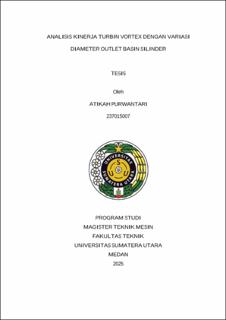| dc.description.abstract | The growing demand for renewable energy has encouraged the development of micro-hydropower technologies capable of operating efficiently under low-head conditions. One promising technology is the Gravitational Water Vortex Power (GWVP) system, which utilizes a vortex turbine to generate electricity from the rotational energy of water vortices in a cylindrical basin. Optimizing the outlet diameter is crucial, as it directly affects flow stability and energy conversion efficiency. This study aims to analyze the performance of a vortex turbine based on outlet diameter variations to identify configurations that enhance efficiency, torque, and power output. The experiments were conducted using a cylindrical vortex basin with outlet diameters of 15 cm, 20 cm, 25 cm, and 30 cm. Impellers with 5, 7, and 9 inclined blades at a 70° angle were tested under three flow velocities (2.0 m/s, 2.2 m/s, and 2.5 m/s). The performance parameters observed included flow rate, rotational speed, torque, power output, and efficiency. The results showed that outlet diameters between 20 cm and 25 cm provided optimal performance. At a flow velocity of 2.2 m/s and a 4.5 kg load, the 20 cm outlet with a 9-blade impeller achieved the highest torque of 10.79 Nm, a maximum power output of 111.48 W and an efficiency of 87.62%. In contrast, the 15 cm outlet created high flow resistance, while the 30 cm outlet induced turbulence that reduced stability and efficiency. Therefore, outlet diameter significantly influences vortex turbine performance. The 20–25 cm range is recommended as the optimal size for maintaining vortex stability and maximizing energy output, particularly in micro-hydro applications for rural or low-head river environments. | en_US |


